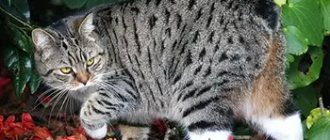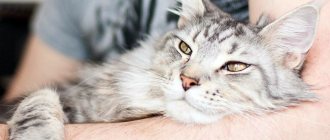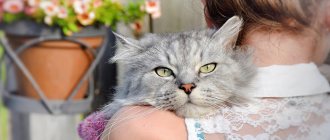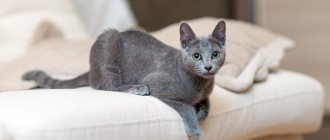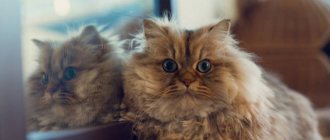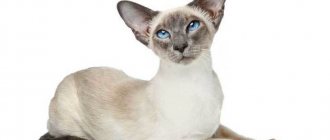A cat is a proud, independent animal, tamed by man, who has become his friend and family pet. A domestic cat is a member of the family for many years, and after a period of “breaking in”, it knows the owner’s character well. The four-legged pet is considered the most popular among other pets. A cat not only brings joy to a person’s life, but also hunts rodents.
Origin and distribution
The forest and steppe subspecies of wild cats were the ancestors of the domestic pet. It is known that the pet began to live with humans about 7 thousand years ago. They were first domesticated by the Egyptians and began to be revered as a sacred animal. Death punishment overtook the cat's killer. And if a furry creature died a natural death in the family, then the ancient Egyptians shaved off their eyebrows as a sign of grief. Burial took place in special cemeteries and in coffins. Being close to people in more comfortable conditions than in nature, the cats gradually lost the pronounced aggressiveness of the predator.
Later, furry beauties inhabited Greece and Rome. The sailors took them on board and thus spread them throughout the Mediterranean, and from there further to Europe and China. By being useful in the fight against rodents, cats have also conquered the human soul. However, in Europe they had to survive. Poor owners of dark fur were tortured and burned. They were considered harbingers of misfortune and the forces of evil.
Everything about cats for children. Interesting Facts
+3
The love for cats all over the world was so great that they created a special holiday for mustachioed and tabby cats. And now every year on March 1, many countries celebrate World Cat Day. And although this holiday is not officially approved, this does not prevent connoisseurs of murkotik from honoring their pets.
In different countries, cat owners celebrate this holiday in different ways. But cats are most congratulated in the UK, because there one cat saves at least 10 tons of grain from rats and mice every year. And in the British Museum, cats officially protect exhibits from mice. When the World Cat Festival arrives, animals who work in the “service of the state” are treated to the best delicacies for cats. In addition, they sew special uniforms for them and make houses for them.
And in Austria there is a special bonus: every cat that protects warehouses from mice for several years is awarded a lifetime pension. It is given out in meat, broth, and milk.
Cat parks are opening in different countries. There are special stores for cats where you can buy not only food for pets, but also clothes and special toys for training. Cafes and hotels are opening where you can lodge your cat for a while.
INTERESTING FACTS ABOUT CATS
According to historical records, the world's first cat, named by its owners, lived in Ancient Egypt in the fifteenth century BC. The owner named her Neji, which translated means “pleasant, sweet.”
Each cat has a unique pattern on its nose. It is as individual as a person's fingerprint.
Scientists - geneticists, heredity specialists have established that all domestic cats - and there are now more than 500 million of them on Earth - are descendants of five wild cats tamed by humans in the Middle East several thousand years ago.
Only cats live on the island of Frajos in the Indian Ocean! They have lived there since 1890, when a ship crashed on the island's coral reefs. The sailors who escaped by reaching land, but without waiting for help, died, and the cats managed not only to survive, but also to reproduce. Currently, more than a thousand cats live on the island.
The cat has also been in space. Russian researchers launched dogs Laika, Belka and Strelka into low-Earth orbit, and the French sent the cat Felicette into space in 1963, which successfully returned to Earth.
The longest cat included in the Guinness Book of Records had a body length of 121.9 centimeters, and the heaviest cat weighed 21.3 kilograms. Usually, high weight is a consequence of obesity, so cat owners are not proud of such records.
The iris of the eye in cats can be blue, green, yellow, amber, gray, brown and even purple. There are cats with eyes of different colors. However, one must be blue.
Source: Magazine “Cotello”, 2021, No. 2
A cat can travel at a top speed of approximately 50 kilometers per hour, almost like a car driving across a bridge. The cat runs only short distances.
A cat can jump to a height five times its own height, but a person cannot do that.
In Russia there is a famous and one-of-a-kind theater led by Yuri Kuklachev, where wonderful cats work. They are looked after by people who love these animals very much.
Yuri Kuklachev with his favorite cats
Photo source: zen.yandex.ru
The first cat exhibition was in 1871 in London. Later, cat shows became popular all over the world.
CAT FAMILY
Our small and affectionate domestic cats are members of the large cat family and can be proud of such giant and formidable relatives as tigers, lions, and leopards. In this article you will learn about the ancestors of cats and their diversity in the modern world.
Felines are a family belonging to the class of mammals. This is the name given to vertebrates whose females give birth to live young and feed them with their milk. You and I are also mammals.
The largest representative of felines and generally one of the largest land predators is the Asian TIGER. This is a very beautiful animal with an orange-black striped skin, allowing it to perfectly camouflage itself in the thickets. Now there are only a few thousand tigers left on earth, about 500 of them (Amur tiger) live in Russia. All tigers are protected, hunting them is prohibited, and their places of residence are protected areas.
LION is the second largest predator of the cat family. Now they can only be found in African savannas (grassy plains). It is interesting that in old age a lion’s mane does not turn grey, but, on the contrary, darkens.
LEOPARD and JAGUAR are big cats that never meet, because the leopard lives in Asia and Africa, and the jaguar lives in Central and South America. The American Indians consider the jaguar to be a deity, and themselves to be its descendants. They are lithe and graceful cats, but they are more than half the size of tigers. They are excellent at climbing trees and swimming in water. In Russia, in the Primorsky Territory, there is a small group of leopards. In Rus', the leopard was called BARS.
The subfamily SMALL CATS includes those representatives of cats that cannot growl. These are quite large animals: CHEETAH, Puma, LYNX.
CHEETAH is the fastest land animal and can reach speeds of up to 115 kilometers per hour. True, such a rapid run can last no more than 20 seconds.
There are a number of small ones: the jungle cat, the sand cat, the Pallas cat, the Chinese cat, the black-footed cat, and the forest cat. All of them, with the exception of the black-footed South African cat, are found in Russia.
Within the species FOREST CAT, zoologists distinguish a subspecies - DOMESTIC CAT. This means that the multi-million army of our pets originated from forest cats.
In our country, cats became widespread only three to four centuries ago.
DOMESTIC CATS AND CARE FOR THEM
“We are responsible for those we have tamed!” So said the wonderful French writer Antoine de Saint-Exupery.
Scientists believe that the process of domestication of animals (zoologists call it DOMESTICATION) began in the Stone Age, when people moved from gathering and hunting to cattle breeding and agriculture, approximately 5-10 thousand years ago. One of the first animals to be domesticated was the dog. Cats began to live with humans much later.
All domestic cats come from Egypt. In Ancient Egypt, cats were highly revered. The famous Greek historian Herodotus, when traveling through Egypt, was shocked by the cult of the cat-headed goddess Bastet. In the ancient Abyssinian kingdom, which was located slightly south of Egypt, cats were also considered sacred. Only the king and his close associates could keep them at home - they were very expensive.
Greece is also not far from Egypt - just cross the Mediterranean Sea. So the cat arrived in Greece on merchant ships. Imbued with respect for the cat, the Greeks began to depict its face on coins! And in the myths of Ancient Greece, the cat was considered the companion of Artemis, the goddess of the hunt. Aesop himself spoke respectfully about cats; one of his fables is dedicated to a cat. Cats were mentioned in the works of great Greek sages such as Plutarch and Aristotle. And always with great admiration! In many ancient beliefs, the cat guarded the hearth. In Greece, these functions were performed by both the cat and the patroness of family comfort, the goddess Hestia.
Over time, the Greeks realized that the cat was also an excellent rodent hunter and protector of crops. But there were too few cats then. And then the Greeks began to steal them from the Egyptians when they sailed to Egypt for goods, usually hiding the murok in deep jugs.
In the first century AD, cats came to Rome, and from there they settled throughout Europe. In France, they were the only animals that were allowed to be kept in monasteries. In the province of Dauphine, near the border with Italy, there is a tradition to celebrate the end of the harvest by decorating village cats with a fringe of flowers and ears of corn - and holding festive dances. Nowadays in France they love cats, and the black cat has even become a symbol of Paris!
Photo source: website “Tailed Tales”
But in the Middle Ages, cats had a hard time: they were considered a fiend of evil and were mercilessly exterminated. There were fewer cats and mice spread fatal diseases among people with impunity. A plague epidemic broke out in France, destroying entire cities. People came to their senses at the end of the 18th century and all ridiculous charges against cats were dropped.
The situation was changed for the better by the legendary Cardinal Richelieu, who was an avid cat lover. Sixteen cats lived in his chambers at once. It was Richelieu who got the first Angora cat in Europe, which was brought from Turkey.
Photo source: Petstory
And England should say “thank you” to the Roman legionnaires. If they had not conquered England in the first century, who would have brought cats there? Over time, the Romans left England, but the cats remained. And it was in England in 1870 that the first cat exhibition was held. Today Birmingham is hosting the largest cat show on the planet. By the way, white cats in England were sold in... pharmacies. It was believed that white cats have the most powerful healing energy.
CAT IN THE HOUSE
Cats, along with dogs, are the most popular companion animals in the world, that is, pets that people keep not for the sake of doing some kind of work, but solely for the pleasure of communicating with them. All people who want to get a cat need to solve several problems. Where can I buy it? You can buy a cat at a pet store or at a cat show. You can borrow from friends or simply bring home an animal found on the street. But the first thing you should do after purchasing a cat is to show it to the veterinarian.
Where will the cat live and who will take care of it? This is the most serious question. Having a cat in your home will change your life, and you need to prepare for it in advance. It is necessary to cover the windows with mesh to prevent the cat from jumping out. You need to choose the places where the cat's bedroom, dining room, toilet will be, and also determine who will clean up after the cat, who will buy and prepare food for it.
For the first few days of a kitten's life in a new home, every time he finishes eating, pick him up and carry him to the litter box. Try to closely monitor the kitten throughout the day. As soon as you see that he has raised his tail and is trying to sit down, take him to the toilet. Cats are very clean animals, and litter training them will only take a few days. But people also need to learn to clean their cat litter regularly: a cat won’t go near a dirty litter box!
It is important to designate places where the cat’s path is closed: the kitchen table, stove, linen closet, and so on. Every time the cat tries to get in there, remove it and strictly say: “No!” or “you can’t!”, or “screw!” Call her by name more often. When the cat does what you want it to do, praise it and give it a treat. And also, you should not shout at cats and under no circumstances should you hit them!
Every cat owner must provide it with all the necessary substances for a balanced diet. Cat food comes in dry and canned forms. It is better to consult a veterinarian on how to properly feed your cat. Many cats cannot digest milk. But fermented milk products: kefir, sour cream, cottage cheese - are both tasty and very healthy for cats. The cat will definitely need two bowls: for food and for water.
In cases where a cat needs to be taken to a veterinary clinic or to a cat show, most owners carry them in a special bag - a carrier. You can walk your cat outside by putting a soft collar around its neck.
FELINOLOGY – THE SCIENCE OF CATS
In the science of animals - zoology - a special section has emerged - felinology. This science studies the anatomy and physiology of domestic cats, cat breeds, and the general principles of breeding and keeping these animals.
Did you know that the sense of touch (the ability to sense touch, heat, cold) is well developed in cats? Their mustaches help them with this. However, long hard hairs on a cat's face are called whiskers only in everyday life. vibrissae to designate them (from the Latin word to vibrate, oscillate). These are special sense organs that perceive the smallest changes occurring near the cat, and not only air movements, but also changes in atmospheric pressure. A cat's whiskers should not be pulled out or trimmed.
The hearing and sense of smell in cats, like hunters, are very well developed. A cat's ear rotates almost 180 degrees, and besides, a cat's ears can move out of sync: one ear can be pointed in one direction, the other can be turned in the other. A cat can simultaneously monitor two different sound sources and navigate in space using hearing no worse than using vision. Cats can catch mice in complete darkness, focusing only on their squeaks and barely audible rustling sounds. In the dark, cats don’t see, they just hear, only much better than we do. Cats are still able to perceive ultrasound, that is, high-frequency sound vibrations that the human ear cannot distinguish.
Typically, in mammals and humans, there are five main types of sensations, five channels for receiving information from the outside world - five senses: vision, hearing, smell, touch and taste. However, sometimes a sense of balance is also added to them. Cats are the absolute champions of maintaining balance. A fantastic sense of balance helps the cat land on its springy paws when falling. Research shows that cat cubs are born blind and deaf, but already have a sense of balance.
A healthy cat's body temperature is always higher than that of a human. Normal temperature is considered to be a thermometer reading of up to 38.5 to 39 degrees. If the temperature rises above 39, then you need to show the animal to the veterinarian.
CAT BREEDS
A breed is a large group of domestic animals distinguished within one species or subspecies. Animals of the same breed must have a common development history and possess a number of common characteristics that are inherited: body type, color...
There are now about 200 cat breeds registered in the world. Breeds are registered by felinological organizations. These are the International Cat Federation, the World Cat Federation, the International Felinological Association, and the Association of Cat Fanciers. Each of them compiles lists of the breeds it recognizes and a detailed description of each, the so-called BREED STANDARD, usually consisting of a description of the external characteristics of the animal. Only cats that meet the breed standard can be considered purebred.
Many cat breeds are named after the place where they were bred or the country where their ancestors were from. So Russian blue, Siamese, Norwegian forest - by their names you can study geography.
Photo source: Pinterest
CAT'S LIFE IN ART
Having been faithful companions to humans for centuries, cats have left their mark on art. Many writers, composers, and artists dedicated their works to cats. Cats are the heroes of many fairy tales. The most famous fairy-tale cat is the hero of Charles Perrault's fairy tale “Puss in Boots.” The French storyteller Charles Perrault wrote down folk tales and gave them literary adaptations. The cat from the French fairy tale is forced to fight not only for his happiness and prosperity, but initially for his own life. The cat surpassed the king himself in dexterity, intelligence, cunning and ingenuity, and then the evil giant, the ogre and the wizard. Smart, dexterous, resourceful, brave - this is how the hero of a French fairy tale appears before readers. In Russian folk tales, a cat is usually a good creature. In the fairy tale “The Cat, the Rooster and the Fox,” he protects his unlucky friend the rooster, saving him from a red-haired predator. In the fairy tale “Kotofey Ivanovich,” a cat who ran away from home married a fox and with her help becomes a king in the forest. And the most amazing fairy-tale cat Bayun lulls everyone who approaches him with his sweet speeches. You, of course, remember how the “learned cat” from A. S. Pushkin’s poem “Ruslan and Lyudmila” “goes to the right - starts a song, to the left - tells a fairy tale.” And the 19th century German writer Hoffmann even wrote a novel... on behalf of the cat, “The Everyday Views of Murr the Cat.”
One of the characters in A. N. Tolstoy’s fairy tale “The Golden Key or the Adventures of Pinocchio,” the cat Basilio does his dirty deeds together with the fox Alice. Let us also recall I. A. Krylov’s fable “The Cat and the Cook,” where the impudent cat ate all the supplies while the cook appealed to his conscience: “And Vaska listens and eats!” This is the Cheshire Cat in L. Carroll’s book “Alice in Wonderland” and “The Cat that Walked by itself” from the fairy tale by R. Kipling and “The Trickster Cat” by K. D. Ushinsky. There is a cat Muryonka in “The Silver Hoof” by P. Bazhev, there is a cat in the fairy tale “Turnip” and in many others.
By the way: in the fairy tale “Turnip”, first published in 1863, nothing is said about the cat. The cat began to be called after the dog Zhuchka only in later versions of this children's fairy tale - its adaptations.
Many poems about cats have been written for children, for example, “Vasily the Cat” by A. Krylov, “Mustachioed - Striped” by S. Marshak, “Cat House”, “Kitten” by E. Blaginina, “The Cat Has a Coo.”
There are many cat monuments in the world. Thus, in Riga, black cat statues are installed on the roof of the Black Cat House. Cats also “walk” on the roof of the Siauliai pharmacy. Residents of the city jokingly call the pharmacy “Valerian”. Because it is known that all cats are not indifferent to her.
In Moscow, on the Patriarch's Ponds, the cat is one of the most expressive characters in the sculptural group of the monument to the fabulist I. A. Krylov. And in St. Petersburg, a monument to a cat was erected in the courtyard of the university.
In Britain there is a monument to a cat named Towser, the famous hunter who caught 30 thousand mice.
But in Japan they believe in cat myths and talismans. Maneki-neko is the main mascot of the Japanese. Translated, this means “Calling cat,” and he calls wealth and good luck to his owner. Manekin-neko is a figurine of a cat whose paw is always raised. In Japan, this gesture means “Come here, please!” If the right paw is raised, it means good luck in business, the left one means well-being in the family. The figurines have multi-colored ears - this is a symbol of a tricolor cat.
Source: Magazine “Cotello”, 2021, No. 5
Cats are often tri-colored, but cats are extremely rare. That's why the Japanese believed that such a cat brings good luck. Fishermen in Japan took calico cats onto their ships and believed: with a mustachioed mascot, the ship would never be wrecked! There is also a bell hanging on the talismans - suzu. There are similar suzus in Japanese temples. Before praying, the Japanese ring a bell to attract the attention of higher powers. Suzu is carried with you and separately from maneki-neko, for example as keychains. By the way, at the entrance to their house, the Japanese place a figurine of a cat. This is a symbol of comfort and family.
We invite you to look at funny drawings of cats from illustrator Irina Zenyuk:
QUIZ “WHAT DO YOU KNOW ABOUT CATS?”
1) What animals belong to the cat family? 2) Where did the domestic cat come from? 3) What breeds of cats do you know? 4) What science studies cats? 5) What color are cats' eyes? 6) What temperature does a cat have that indicates that it is sick? 7) Can cats see at night? What are whiskers in cats, why do they need them? 9) What can a cat do that a person cannot do? 10) How should you care for a cat? 11) Name fairy tales where one of the characters is a cat? 12) What monuments to cats are there?
2) Where did the domestic cat come from? 3) What breeds of cats do you know? 4) What science studies cats? 5) What color are cats' eyes? 6) What temperature does a cat have that indicates that it is sick? 7) Can cats see at night? What are whiskers in cats, why do they need them? 9) What can a cat do that a person cannot do? 10) How should you care for a cat? 11) Name fairy tales where one of the characters is a cat? 12) What monuments to cats are there?
You can answer all these questions if you carefully read our article about cats.
Sources:
Children's encyclopedia. Shironina E.V. Cats. - M.: ROSMEN - PRESS, 2013. - 96 p.: ill. Magazines “Kotello”, 2021, No. 1 – 6. Poems and stories about mom. – M.: Astrel, 2007 – 222 p.: ill. Poems for your favorite holidays. (Textbook for children of early school age). - M: Astrel, 2002 - 60 pp.: ill.
Facebook Comments
Types of cats: description
Such pets may have long fur.
According to statistics, the domestic cat species makes up the majority of all its relatives (the population is about 90%), in contrast to purebred specimens (they make up only 2-10%). The name allows us to summarize all varieties of pets that do not fit the scientific description of breeds. An ordinary cat is classified by length, type and color of coat, and size. There are long-haired and short-haired, curly and hairless, large and dwarf. The shape and length of the tail and ears are important: tailless (Manx) and bobtails.
The description of a cat depends on its habitat. Thus, the northern varieties are large, muscular, with thick hair. Southern mongrel cats are short-haired, without undercoat, graceful and graceful. Inhabitants of western latitudes can boast of a natural blue tint of fur, but the characteristics of color variations often come down to brindle, red, 2 or 3 colors. The scientific community has not been able to reach a consensus on the origin, classification and abundance of the species.
Hairless
Don Sphynx
Don Sphynxes are affectionate, non-aggressive, and playful. They have somewhat dog-like habits, while remaining unobtrusive and tactful.
Breed characteristics
- Hairless cover;
- medium sized body;
- big ears; expressive almond-shaped eyes;
- pronounced eyebrows and cheekbones;
- long graceful paws.
Canadian Sphynx
The Canadian Sphynx is the first recognized breed of hairless cat. All Sphynx cats are characterized by increased body temperature and the ability to tan. They become very attached to their owners. These creatures need constant communication. Canadians are very smart and learn new things easily. They are friendly with absolutely everyone and get along great with children.
Breed characteristics
- Hairless cover;
- dense muscular body;
- folds on the skin;
- the forelimbs are shorter than the hind limbs;
- large wide ears with rounded tips.
Petersburg Sphinx
Of all the types of sphinxes, the Petersburg, or Peterbald, is the most graceful. He looks more like an oriental cat than other sphinxes. The Peterbald is a companion cat; he does not like to walk on his own. Thanks to the presence of Siamese-Oriental cat breeds in the pedigree, the Peterbald is very active. His character retains all the traits characteristic of the ancestors of other breeds: lack of aggression, sociability and love.
Breed characteristics
- Hairless cover;
- thin, invisible undercoat;
- small wedge-shaped head with huge ears;
- blue or green eyes;
- long nose, straight profile.
Characteristics of a domestic cat: appearance and character
A simple cat distinguishes colors and sees well in the dark. The sense of smell is well developed, not inferior to that of a dog.
The body of the animal is harmoniously developed and on average has a length of about half a meter.
The external characteristics of pets are incredibly diverse, but common features for all can be identified:
- The head is round, somewhat flattened, with erect ears.
- The muzzle is short, wide jaws, sharp teeth. The male differs from the female in having a wider forehead.
- The eyes are expressive, large, slightly rounded. A special feature is the presence of a nictitating membrane, which performs a protective and cleansing function.
- Torso. Proportionally developed, 50-70 cm long.
- The ears are developed and turn towards the sound.
- Whiskers and vibrissae. Helps you navigate the terrain and in the dark.
- Limbs and joints. They are distinguished by flexibility and resourcefulness. The pet can be described as an excellent athlete.
Characteristics of a pet:
- Quite developed intelligence, which facilitates everyday communication.
- Strong attachment to one's home and owner.
- Pride and independence of character. They are difficult to train.
Features of behavior
With the help of hissing, the animal expresses certain emotions.
The sounds produced are meowing, purring, hissing, howling, squeaking. These are all ways to express yourself and attract attention. Tail movements can also tell a lot. A curled or raised tail indicates a friendly disposition, frequent tapping indicates irritation and dissatisfaction, and a twitching tip indicates excitement and interest. In addition, the tail performs steering functions. When falling from a height, an animal always lands on its paws. The cat shows contentment with life by stretching its body, simultaneously releasing its claws and pleasantly purring.
The cat perceives moving objects in the house as prey and begins to “hunt”. While playing with a person, a domestic cat bites the wrist, thinking it is the victim's neck. At the same time, they have an instinct of self-preservation, laid down in ancient times. By moving around the perimeter, rather than directly, they seem to bypass the enemy. During introductions, cats sniff their noses. The lowering of the head of one of them speaks of the peace process and submission.
Habits of cats
Cats are carnivores, being small predators. At the same time, they can eat plant foods, but they still cannot do without meat. Their diet in the wild consists of small mammals (especially rodents), amphibians, amphibians, fish, birds and insects. However, pets usually do not neglect hunting animals, even if they have plenty of food.
Interestingly, cats sleep most of the day, usually from 12 to 16 hours a day. Some breeds can spend up to 20 hours in a sleepy state, and small kittens even sleep up to 23 hours a day. Animals spend the remaining time searching for and eating food, grooming themselves, playing and having fun.
By lying on their backs, cats show their trust in humans. And lifting your tail up - your love. If a pet wags its tail, this means doubt, difficulty in choosing. They meow only to people, attracting human attention. And they express their pleasure by purring or spreading their fingers. Animals demonstrate their fear with raised fur and flattened ears. However, even identical gestures do not always carry the same meaning, especially among different felines.
About the health of a mongrel pet
If your pet's nose becomes hot and dry, then he is probably sick with something.
Responsibility for the well-being of a pet lies with the owner. Unusual behavior, attempts to find a secluded place and sit there should alert household members. Suspicions will be confirmed if the cat has a hot, dry nose, drinks a lot, breathes frequently and does not eat. Photophobia and unmotivated aggression are included in the description of rabies. Attentiveness to your pet will not allow you to miss this dangerous disease. It is better not to postpone a visit to the veterinarian, but communication between family members and the cat is limited. Regular brushing, water treatments, and eye and ear hygiene will help keep your cat healthy.
The benefits of cats in the house
But even now there are many signs associated with cats, but all these signs have a completely material basis and do not cause the animals any particular trouble.
Even amazingly beautiful black cats - some people consider them harbingers of misfortune, but many, on the contrary, are convinced that they bring good luck and health to the house in which they live, and they really do! But when a cat sneezes, you must definitely tell her “be healthy” so that her teeth never hurt!
Even in houses where there have never been mice or evil spirits, cats are kept - wonderful, playful and kind animals that delight and warm the soul and save from loneliness. Cats, despite their independence, also need the company of people; they suffer greatly from the lack of love from their owners.
What to feed?
Cats have well-developed taste buds on their tongue. They distinguish between sour, salty, bitter and sweet.
The food tract of cats is accustomed to meat. Sharp fangs crush it, and the tubercles on the sides of the tongue help separate the pulp from the bones. The meat menu needs to be diversified with other high protein foods - fish, eggs, dairy products. Carbohydrates are needed in small quantities - cereals, vegetables, bread. Eating too much food leads to obesity, and a normal human diet is harmful to a cat. Periodically, the cat's stomach is cleared of undigested residues. To do this, the mustache “snacks” on grass, leaves, and at home – on house plants, for example, aloe. Sometimes the “hunter” eats soil, which indicates a lack of microelements. They are always included in cat food.
How many years does a cat live?
What is the life expectancy of cats?
Cats live on average 13-18 years
. Under very favorable conditions, they live up to 20.
There have been many cases recorded on earth where cats lived much longer.
So, on November 5, 1957, the cat Mao (owner A. St. George Moore) died at the age of 34 years. And the cat Puss (owner T. Hollway) lived the longest, who died on November 29, 1939 (the day after his birthday) at the age of 36 years!
There is information that now the oldest cat is considered to be a cat named Lucy. This “old lady” is already 39 years old!
Interesting breeds
There are breeds developed by crossing wild and domestic cats:
- Bengal - a hybrid with wild Bengal;
- Savannah - crossbreeding with the African Serval.
In case of unusual mutations, they try to fix new characteristics. These are hairless sphinxes, Scottish folds, short-legged munchkins, and curly rexes.
Rice. 3. Bengal cat.
Protection from loneliness
Another reason to get a cat is that you will never be alone. The pet will look forward to your return from work, will be sincerely happy, and will check what is in the bag. Positive emotions are guaranteed to you.
The animal will accompany its loving owner, move around the apartment with him, and watch how he performs household duties. You will forever forget what loneliness is. Even on the gloomiest day, a loving cat will improve your mood and warm you with its warmth.
A little mysticism
Cats sense the presence of negative energy in the house. If the animal looks into an empty corner and growls, perhaps you should call a priest or esotericist to clean the apartment. Feng Shui experts believe that cats will tell you where the ideal area for sleeping is located in your home. See where your cat likes to sleep. This is the best place in the house. It is recommended to place a bed here.
There is an old sign that says that a cat should be the first to enter a new house. It is believed that it helps to exorcise evil spirits or cleanse the home of negative energy.
Helpers in your personal life
If you are a single man and are looking for your soulmate, a cat is simply necessary for you. The fact is that women consider cat owners to be more suitable candidates for serious relationships. Your favorite pet will become a competitive advantage for you and will help you go on a long-awaited date.
Print and bright jewelry: spring 2021 trends that suit women over 40
Taurus are very devoted to their owner: the dog’s horoscope will tell you about the dog’s character
Separate sleep and strollers: which Western traditions of child care are alien to us
Lifestyle
The cat is a nocturnal animal; it prefers to nap during the day and to walk and hunt in the evening and at night. For those who live in an apartment, this is inconvenient, but many cats get used to the rhythm of life of their owners.
- Free-roaming cats hunt mice, moles, frogs, and beetles. They love to play with a lump of soil, a dry leaf, and jump after butterflies. When kept in an apartment, an animal needs toys for movement.
- Hunting does not replace homemade food. Modern dry and wet food are designed for cats of different health conditions and ages.
- The design of cat paws allows the claws, which are constantly growing, to be retracted. During a walk, a cat wears its claws off on tree trunks; at home, you need a scratching post. Overgrown claws injure the pads, so they are trimmed.
- Cats with long hair need to be brushed regularly and tangles cut off.
A story about a cat would be incomplete without mentioning kittens. Usually 4–5 helpless, blind, deaf kittens are born. For convenience, the family is placed in a spacious basket or box, which is placed in a place where there are no drafts. By 10–11 days, kittens can see and hear. Breastfeeding lasts 8–10 weeks.
In Japan, Tashiro Island is home to more than 500 cats, with a local population of 70–100 people. The first cats were brought in in the 17th century to protect silk cocoons from mice and rats. Numerous tourists help maintain the cat colony.
Rice. 2. Island of cats Tashiro.

